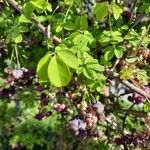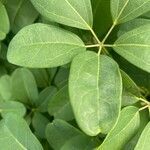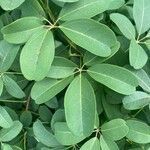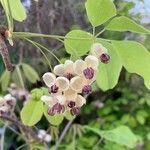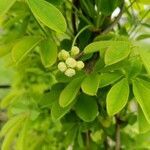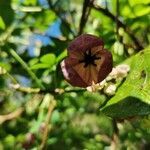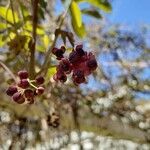High-climbing liane, deciduous, or ± evergreen in mild climates. Petioles to c. 12 cm long. Leaflets 5, entire; petiolules to 2 cm long on larger leaflets. Lamina of largest leaflet 3-6 × 2-4 cm, elliptic to obovate; base cuneate to rounded; basal pair of leaflets considerably smaller. Racemes 5-9 cm long, usually with 2 ♀ and 4-6 ♂ fls; fls fragrant. Peduncles slender; bracts of ♀ fls 3-5 mm long, lanceolate, acuminate; bracts of ♂ fls smaller. Pedicels filiform, much > bracts. Sepals of ♂ fls c. 6 mm long, broad-elliptic to suborbicular, valvate, pinkish purple. Stamens 3-4 mm long, incurved. Sepals of ♀ fls 11-15 mm long, suborbicular, concave, scarcely valvate, purple. Ovary of 3-6 carpels, each 4-6 mm long; stigma with prominent glistening mucilage. Fr. 8-9 cm long, sausage-shaped, mauve or purple.
Plants , deciduous to semi-evergreen, climbing to 12 m, glabrous. Leaves: petiole 1.6-12.5 cm; leaflets mostly 5, petiolules 0.2-2.2 cm, blades oblong to ovate-elliptic, 0.7-8.2 × 0.4-4.2 cm, base rounded, margins entire, apex retuse. Inflorescences pendent, 4.5-12 cm; pedicel with basal bracts. Flowers fragrant. Staminate flowers 4-15 per inflorescence, 1.2-1.6 cm diam.; sepals oblong to ovate or elliptic, 5-9 mm; stamens 4-5 mm. Pistillate flowers (0-)1-5 per inflorescence, 2-3 cm diam.; sepals elliptic to ovate or nearly orbiculate, 10 16mm; pistils 3-7, 1 or more maturing. Follicles glaucous, violet to dark purple, oblong, 5-15 cm. Seeds black, ovoid, embedded in whitish pulp.
A climber which grows 12 m long. It twines around objects and climbs. The stems are dark purple-red. Where winters are mild they keep their leaves year round. The leaves are made up of 5 oval leaflets. Each leaflet is about 5 cm long. Male and female flowers are separate. The flowers have a sweet smell and appear in clusters. Female flowers are purplish-brown and 2-3 cm across. They are cup-shaped. The male flowers are smaller and rose-purple. The fruit is 5-10 cm long and 5 cm wide. It is sausage shaped and grey-violet. The seeds are black in a white pulp. There are 40-50 seeds. The pulp is edible.
A native of e. Asia, sometimes escapes from cult. It is a high-climbing woody twiner, with 5 retuse lfls and fragrant, purplish-brown fls in small, axillary racemes, the lower pistillate, 2–3 cm wide, the upper staminate and smaller; 2n=32.
